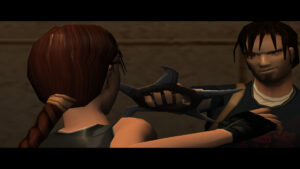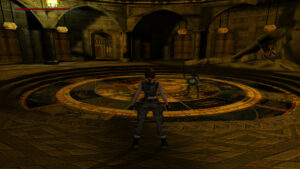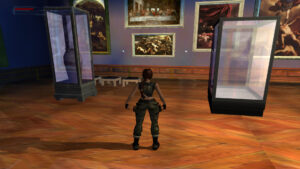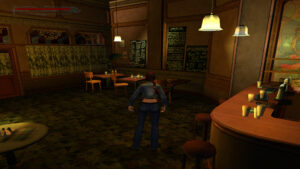TR6: Leaving the Louvre
The climax of the Louvre is a boss fight where you’re chased around a crypt by a ghost. I had to hit up some hints to find out what I was supposed to be doing here. You can’t kill the ghost, and to my eye, the game doesn’t adequately indicate your goals or the effects of your actions. The whole thing hinges on realizing that if you shoot the ghost a whole lot, eventually it stops moving for a few seconds, and you have to take advantage of this before it wakes up again. Without the walkthrough, I couldn’t tell that these pauses weren’t part of its normal movement cycle.
After you get what you need and run away, leaving the guardian ghost protecting nothing for all eternity, the game does two notable things. First, it takes the unusual step (for a Tomb Raider) of making you backtrack through the way in. Usually the treasure room in these games has one-way entrances and exits, if the need to get out is acknowledged at all. Here, you make your way back through the same levels you went through to get in, albeit mostly in abbreviated form — one section, previously seen as a difficult climb downward, is made easier by flooding the chamber, letting you simply swim to the top. On the way out, the Louvre gallery itself is swarming with heavily-armed bad guys looking for Lara and her loot, recontextualizing the space, adding danger to areas that were safe bafore.
 The second notable thing is the introduction of a hunk. A young man with a smoldering gaze, a lean and athletic build, artfully unkempt hair, and just enough stubble to establish his masculinity, as well as apparent telekinetic powers and some kind of magic shuriken. He doesn’t have a name yet — he hasn’t spoken a word — but I noticed some mentions of a Kurtis in those walkthroughs, and image searches confirm that’s who he is. He’s not exactly on Lara’s side, but he’s definitely supposed to be a potential love interest, and also Lara’s equal, both of which are things she’s never had before. His introduction is the longest in-engine cutcene so far, and it starts with him getting the drop on her, putting a gun to her head (which probably counts as flirtation for creatures such as they), and slowly, seductively stripping her of her weapons. It’s a scene that’s inevitably a bit laughable, if you feel like laughing at it, but it’s also a fairly impressive showcase of the engine’s ability to handle acting without dialogue, as we see Lara react with surprise, desire, and annoyance all at once, mainly just through body language, without changing her facial expression. And it strikes me as fairly significant that the first spark of romance in the series starts by putting the strong-willed and self-sufficient Lara into a rare situation of helplessness.
The second notable thing is the introduction of a hunk. A young man with a smoldering gaze, a lean and athletic build, artfully unkempt hair, and just enough stubble to establish his masculinity, as well as apparent telekinetic powers and some kind of magic shuriken. He doesn’t have a name yet — he hasn’t spoken a word — but I noticed some mentions of a Kurtis in those walkthroughs, and image searches confirm that’s who he is. He’s not exactly on Lara’s side, but he’s definitely supposed to be a potential love interest, and also Lara’s equal, both of which are things she’s never had before. His introduction is the longest in-engine cutcene so far, and it starts with him getting the drop on her, putting a gun to her head (which probably counts as flirtation for creatures such as they), and slowly, seductively stripping her of her weapons. It’s a scene that’s inevitably a bit laughable, if you feel like laughing at it, but it’s also a fairly impressive showcase of the engine’s ability to handle acting without dialogue, as we see Lara react with surprise, desire, and annoyance all at once, mainly just through body language, without changing her facial expression. And it strikes me as fairly significant that the first spark of romance in the series starts by putting the strong-willed and self-sufficient Lara into a rare situation of helplessness.
 Comments(0)
Comments(0)

